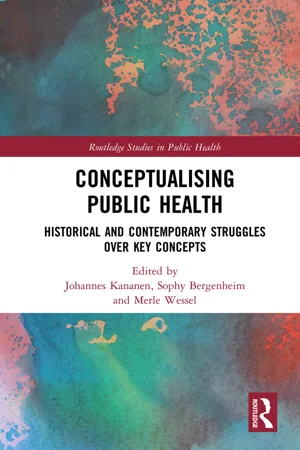
Conceptualising Public Health
Historical and Contemporary Struggles over Key Concepts
- 227 pages
- English
- ePUB (mobile friendly)
- Available on iOS & Android
Conceptualising Public Health
Historical and Contemporary Struggles over Key Concepts
About This Book
In Germanic and Nordic languages, the term for 'public health' literally translates to 'people's health', for example Volksgesundheit in German, folkhälsa in Swedish and kansanterveys in Finnish. Covering a period stretching from the late nineteenth century to the present day, this book discusses how understandings and meanings of public health have developed in their political and social context, identifying ruptures and redefinitions in its conceptualisation. It analyses the multifaceted and interactive rhetorical play through which key concepts have been used as political tools, on the one hand, and shaped the understanding and operating environment of public health, on the other.
Focusing on the blurred boundaries between the social and the medico-scientific realms, from social hygiene to population policy, Conceptualising Public Health explores the sometimes contradictory and paradoxical normative aims associated with the promotion of public health. Providing examples from Northern Europe and the Nordic countries, whilst situating them in a larger European and international context, it addresses questions such as:
-
- How have public health concepts been used in government and associated administrative practices from the early twentieth century up to the present?
-
- How has health citizenship been constructed over time?
-
- How has the collective entity of 'the people' been associated with and reflected in public health concepts?
Drawn from a range of disciplinary backgrounds, the authors collected here each examine a particular way of understanding public health and assess how key actors or phenomena have challenged, altered or confirmed past and present meanings of the concept. Conceptualising Public Health is of interest to students and scholars of health and welfare state development from diverse backgrounds, including public health, sociology of health and illness, and social policy as well as medical, conceptual and intellectual history.
Frequently asked questions
Information
1 Conceptualising public health
Studying key concepts of public health: The aim of this book
Historical development in the nineteenth and twentieth centuries
Disease prevention in the collective
Its first object is to check the birth-rate of the Unfit, instead of allowing them to come into being, though doomed in large numbers to perish prematurely. The second object is the improvement of the race by furthering the productivity of the Fit by early marriages and healthful rearing of their children. Natural selection rests upon excessive production and wholesale destruction; Eugenics on bringing no more individuals into the world than can be properly cared for, and those only of the best stock.9
Table of contents
- Cover
- Half Title
- Title Page
- Copyright Page
- Table of Contents
- List of figures
- Contributors
- Acknowledgements
- 1 Conceptualising public health: An introduction
- 2 Conceptualising eugenics and racial hygiene as public health theory and practice
- 3 Female doctors, prophylactic health care and public health
- 4 The Nazis’ cloven hoof: Finnish critiques of legal sterilisation
- 5 Universal, but exclusive? The shifting meanings of pre- and post-war public health in Finland
- 6 The people’s health, the nation’s health, the world’s health: Folkhälsa and folkehelse in the writings of Axel Höjer and Karl Evang
- 7 Cherishing the health of the people: Finnish non-governmental expert organisations as constructors of public health and the ‘people’
- 8 Public health categories in the making of citizenship: The case of refugees and Roma in Sweden
- 9 Alcohol consumption as a public health problem 1885–1992
- 10 Mainstreaming concepts, discounting variations? Global policies of alcohol, drugs and tobacco
- 11 Science, politics and public health: The North Karelia Project 1972–1997
- 12 The individualisation of health in late modernity
- 13 Editors’ notes: Transitions in the conceptual history of public health
- Index